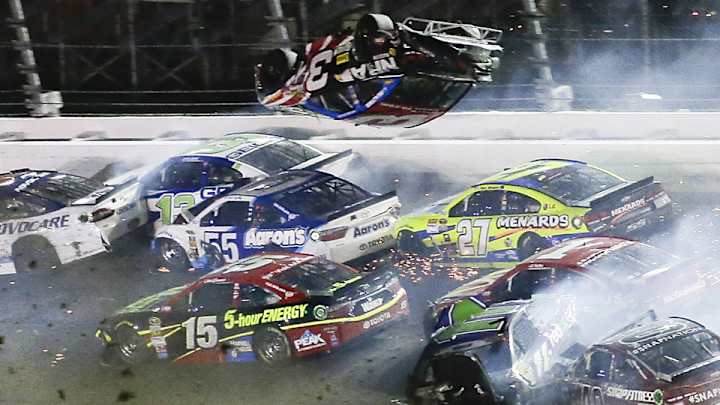With 2015 Rules Package, NASCAR shows willingness to change

In racing, as in life, the only constant is change. The cars, the tracks, the process through which champions are crowned—all of it seems to get pounded, like clay, into a formless blob the moment anything distinctive takes shape.
This is especially true of NASCAR, which once again finds itself in throes of a heavy drafting phase. Before this Saturday’s Sprint Cup race in Sparta, Ky., which airs at 7:30 p.m. ET on NBCSN, the Association called for a revised set of engineering standards for the race cars. Among other things, it mandated reductions in the sizes of the rear spoiler (to 3 1/2 inches from six inches) and the front splitter (which now must be 1 3/4 inches shorter). The general idea is to encourage more passing under green flag racing conditions.
That outcome, of a piece with a larger NASCAR effort to foster parity, is something drivers have demanded for ages and with just about as much effect as fans. Actually, the two parties seemed just about equal in terms of sway—neither appeared to have much. At least, that was the case until a cross section of the Cup series’ biggest stars met with NASCAR officials before a race in Dover, Del., in what would become their first formal act as a drivers’ counsel. Their agenda, according to veteran Cup driver Greg Biffle, who is not part of the counsel but a party to their discussions, was “great racing, close side-by-side racing [that’s] competitive and safe for the drivers.”
NASCAR should prove it's colorblind, ban confederate flag from racetracks
The updated rules package for Kentucky, which was announced on the heels of that landmark meeting in Dover, would appear to be a major victory for the drivers and the first in many sweet spoils there for the taking, provided they keep drawing on their tremendous horsepower in numbers. And it is a major victory, one that NASCAR is claiming for itself as well. Why? Because the rules rewrites are still in keeping with a competitive vision that the league has been crafting for years.
The effort started over with the rollout of the Gen 6 car in 2013 and persisted through the beginning of this season, when NASCAR introduced a fresh round of engineering and aerodynamic standards intended to create tighter racing packs, improve handling and encourage more passing. Through the 2015 Rules Package, a name that is slightly misleading because setup rules change slightly from one track to the next, NASCAR says it has indeed created the passing opportunities that it hoped to see—just not at the front of the pack. (Never mind the fact that 13 drivers have won the first 17 Cup events going into the Kentucky Cup race.)
Hence, the impulse to shake up things in the middle of the season. After Kentucky, NASCAR will run its races at Indianapolis (on June 26), Michigan (on Aug. 16), Darlington (on Sept. 6) and Richmond (on Sept. 12) under tweaked regulations. At the intermediate tracks of Kentucky and Darlington, the object is to decrease the down force. At the bigger tracks of Indy and Michigan, it’s to increase drag. At Richmond, the smallest track and the staging ground for the Cup series’ regular season finale, teams will race on softer, tackier tires in an attempt to reduce cornering speeds and turn the 3/4-mile track’s protracted bends into a more fertile overtaking zone.
That push-pull between down force and drag is constant. Drivers would rather a decrease in drag take the lead in the prioritizing, while team engineers would rather drag followed down force. The premium these engineers put on keeping the cars firmly planted on the ground has become easier to understand in the wake of two spectacular crashes in four days’ time.
The first, during the Cup race at Daytona in the small hours of Monday morning, saw Austin Dillon fly over two rows of traffic and smash into the catch fence. The second, which happened in Thursday’s truck race at Kentucky, saw Ben Kennedy’s evening end in much the same fashion. This, despite the fact that the circumstances leading to these crashes—one, in a restrictor plate race where Cup cars cut through the air like darts; the other, featuring a far grippier machine with significantly less horsepower on a much shorter track—couldn’t be more different. Such are the hazards in this delicate dance.
• MORE NASCAR: Latest Sprint Cup standings after Coke Zero 400
The important thing to keep in mind throughout all the fettling is that none of these tracks recurs during the Chase, which is no less immune to adjustment, according to NASCAR competition czar Steve O’Donnell. An earlier rules change for this season—namely, the fact that teams can’t do any advance testing to acclimatize their equipment to a particular track—keeps the bigger, richer Cup teams from investing piles of time and money into independent R&D. Instead, all live fine-tuning will happen on race weekend during practice, which keeps the playing field level. And that, as ever, is the point.
Man, not machine, is meant to be NASCAR’s biggest star, after all. But it takes constant change to preserve the humanity in racing. So credit NASCAR with this much: at least on the issue of competition, they’re not afraid to evolve. The moment drivers catch up will be the moment it’s time to change all over again.
